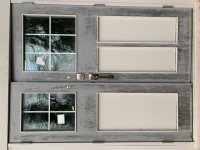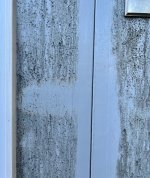dlu
Member
We live in the Pacific NW (USA) and on exterior plywood surfaces painted with Benjamin Moore exterior latex (supposedly with a mildew inhibitor mixed in) we're seeing a black growth that I assume is mildew. This only seems to be happening on plywood surfaces. In the photo below you can see it on areas of the door, but not around the edges. The door is a plywood lamination with solid wood "edgebanding" -- notice how the mildew does not reach out the edges of the door.
Any thoughts about why this might be happening? It's happening in a number of locations, with different plywood (mostly Arauco ACX underlayment and a sande marine plywood) and different -- I think -- paint batches.
Any thoughts about why this might be happening? It's happening in a number of locations, with different plywood (mostly Arauco ACX underlayment and a sande marine plywood) and different -- I think -- paint batches.


